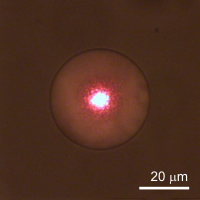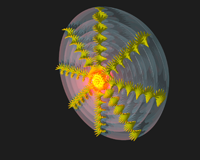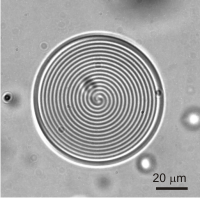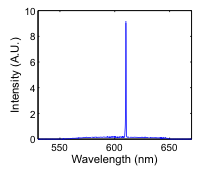3D lasers in cholecteric liquid crystal droplets

a pulsed laser (VIDEO).
Microlasers are important building blocks for many applications like integrated photonics, telecommunication, holography, imaging and sensing. Desirable properties are small size, narrow linewidth, tunability and low-cost production. Liquid crystal lasers have all of these properties.
In this work we extended cholesteric lasers from planar geometry to spherical geometry. By mechanical mixing a small quantity of dye doped cholesteric liquid crystal with glycerol, we produced thousands of spherulite type droplets. The droplets have onion structure that confines light to the center of the droplet by Bragg reflection from the cholesteric layers. Such microcavities have completely spherically symmetric bandgap. By doping the liquid crystal with a fluorescent dye (nile red) and illuminating a droplet with a green pulsed laser, we can achieve lasing from the center of the droplet. The lasing wavelength is either at long or at short edge of the reflection bandgap, the same as in planar cholesteric lasers. The lasing linewidth is quite narrow, 0.01 nm. We also measured the angular dependence of laser emission. We found that the laser emits light uniformly in all directions in space, acting as a truly isotropic point source of coherent light. By changing the temperature, we can vary the cholesteric pitch and in this way we can tune the emission wavelength by almost 50 nm.
In conclusion, lasing in cholesteric droplets has been achieved for the first time. Such laser is one of the first lasers that emit light in all the directions and as such, it is a true point source of light. It has single mode operation, narrow linewidth and high tunability. It is also one of the few microcavities that have completely symmetric full bandgap. What is even more important, it is one of the easiest lasers to make in general. It is only necessary to mix four components that are commercially available: liquid crystal, chiral dopant, laser dye and glycerol.
M. Humar and I. Muševič, 3D microlasers from self-assembled cholesteric liquid-crystal microdroplets, Optics Express 18, 26995-27003 (2010).





